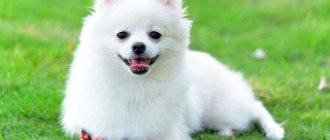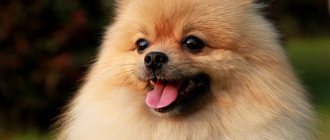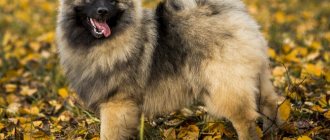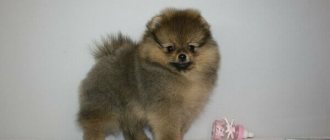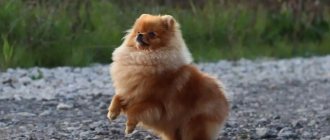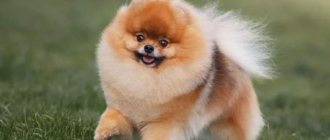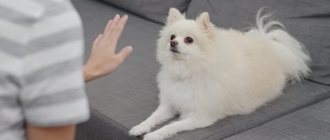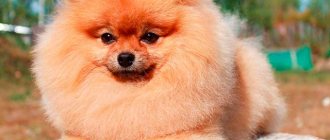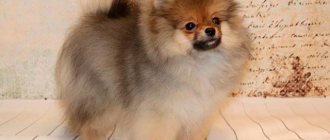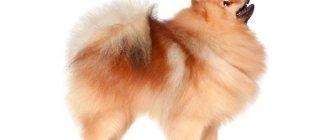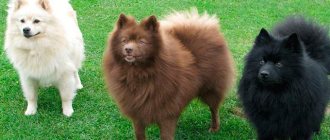Despite the fact that the Pomeranian Spitz was bred in the 19th century, cynologists immediately determined the breed standard. Some additions were made later, but the standards did not change. The exhibition of the first breeding Spitz was held in 1909, and the breed Stud Book appeared a few years later - in 1913. After some time, American cynologists intervened in the genes of the German Spitz and were able to create a stronger breed line in terms of health and appearance. In Russia, the standard was approved in 1998 by the RKF association. So the Pomeranian Spitz, the breed standard, acquired another version (before that there were FCI, AKC).
The Pomeranian Spitz is considered a very ancient breed.
Dimensions
In order for a dog to be admitted to the exhibition, its weight must be between 1.4 kilograms and 3.2 kilograms. Ideally, a Pomeranian should weigh between 1.8 kilograms and 2.3 kilograms. Weight should correspond to height.
According to the standard, the height of a Spitz should be 18-22 centimeters. If the height is less than 18 cm, then this is considered a defect. The main dimensions and how much Pomeranian Spitz weigh can be examined in detail in the following table of the height and weight of an adult dog:
Proportions
Harmony in coherence, dense and strong physique are the hallmarks of this breed. The paws are of medium length and distributed in proportion to the body, which together gives a good balance of stability.
The ratio of the dog's height to body length is 1:1, which means it has a square shape.
Body type
The body of a Pomeranian, according to the standard, should be rounded, with a deep, but not too voluminous chest.
Temperament
The most important thing for a Spitz is its cheerfulness. He is always ready for any adventure, is happy to go for a walk and will support his owner in everything. The cheerful disposition and devotion make dogs of this breed the most preferable for friendship and protection.
Loud barking will notify you of the arrival of guests, and the joy from spending time together will be immeasurable.
A properly styled haircut looks elegant
Head
The head is in proportion to the dog's body. It has a wedge shape, reminiscent of a fox skull.
The dark-colored eyes are medium in size and are not too close, but not too far apart. In a healthy dog they should shine. Monochrome representatives of the breed have blue and brown shades and there is no pigmentation around the eyes. In other cases, there is black pigmentation near the eyes.
The ears are relatively close to each other and small in size. In a Pomeranian, they should always be in a standing position, triangular in shape.
The skull is of medium size and quite wide between the ears. Tapering towards the nose, it has a well-defined transition from the muzzle to the forehead. The rounded forehead is quite voluminous.
If a Pomeranian Spitz has a domed, rounded skull, then, according to the standard, this is a defect.
The dog's non-pointed muzzle is very thin and has a pronounced transition. The length of the skull to the length of the muzzle has a ratio of 1:2. The cheekbones are rounded and should not protrude.
The small, round nose is black in color. The exception is the brown Pomeranian representatives of the breed - their nose is dark brown.
The absence of pigmentation on the lips is acceptable only in Pomeranians of the same color brown and blue colors. In all other cases, there should be black pigmentation near the lips.
A dog's correct set of teeth should consist of forty-two small teeth. This small breed may be missing some premolars.
The bite is a scissor bite, meaning the inner surface of the upper jaw should barely touch the outer surface of the lower jaw. One protruding tooth is not considered a defect by the standard, but if the entire lower jaw protrudes, this is already a defect.
History of the breed
The birthplace of dog breeding is Pomerania, a German province located in the south of the Baltic Sea. It was in honor of the historical region that the breed was named. At the moment, this is the territory of modern Vorpommern in western Germany.
At the beginning of the 1700s, they were breeding white dogs called Pommirles. Württemberg is a breeding place for representatives of the black breed. They were bred to protect vineyards. Those dogs were much larger than modern Spitz dogs. Their breeding and use were mainly carried out by people of lower society.
Later, in the 18th century, high society began to show interest in them, turning them into elite pets. Queen Charlotte of England brought a Spitz from Pomerania to her native Macklenburg for her own amusement. But from that moment on, they began to seriously engage in dog breeding. Spitz dogs are registered as an official breed. Breeders began to carefully select and select pairs for further crossing. The professionals' goal was to use the best specimens.
Gradually, the size of the dogs began to decrease; they no longer weighed 9-14 kg as before.
Victoria, the granddaughter of Queen Charlotte, became the head of the English Club breeding Pomeranians in 1871. An official standard was adopted by community members.
A little later, in 1899, a similar club appeared in Germany, where dogs of different colors and sizes were bred.
The year 1913 was marked by the registration of the first stud book. It was used to record the resulting offspring. The facts of the birth of puppies were entered into the book only after the producers received exhibition ratings.
The First World War left its mark on the breed: part of the livestock was on the verge of destruction. Amateur dog breeders began to import dogs from European countries. But attempts to revive the breed were unsuccessful due to the Second World War. After peace was established, the members of the German Spitz club revised the standard, which has partially survived to this day.
At what age do Spitz dogs shed?
Frame
According to the standard, the body of representatives of the Pomeranian Spitz breed should be stocky and round in shape. Well-developed, rounded ribs frame a toned abdomen. The skin, which fits tightly to the body, does not form folds.
The powerful back of short length has the shape of a straight line and is well developed. In order for a Pomeranian to lift its head high, it must have oblique shoulder blades.
The strong, small loin has a slightly convex shape.
The dog's neck is pulled back at the shoulders, continuing the straight line of the back. The fluffy undercoat makes the neck seem very small.
The chest of representatives of this breed should be deep, but at the same time not too voluminous.
The tail is one of the most distinctive features of the Pomeranian. According to the standard, it must be level and high above the back, thereby rounding the dog’s silhouette. The tip of the tail curls.
Males should have two well-developed testicles that are completely located in the scrotum.
Maintenance and care
The Pomeranian Spitz is a fairly unpretentious pet that adapts to any living conditions. Thanks to its thick coat, it does not freeze in winter and easily tolerates summer heat. But due to the short muzzle, heat exchange in these dogs is poor. Therefore, you cannot keep them outside; the Pomeranian is an indoor pet. You can toilet train at home using a diaper. But you still need to take him outside to run for at least an hour a day.
Apart from grooming, other hygiene procedures are the same as for other dogs:
- brush your teeth once a week and give chewing bones;
- check and wipe your eyes and ears daily;
- Trim nails monthly.
Grooming
The thick, long coat of Pomeranians needs to be brushed well every few days. This will prevent the formation of tangles. To remove dead hairs, the comb movements should be directed against the hair.
You should not often bathe your Pomeranian. His skin is prone to dryness and allergies. It is recommended to completely wash it only if it is heavily soiled, or after shedding. Be sure to use a special shampoo and conditioner. After a walk, you can wash your paws and belly, and if necessary, wipe the fur with a damp towel.
Many owners give their pets haircuts. When the fur is short, it is easier to care for, and the fluffy bear turns into a fun plush toy. But experts do not recommend cutting these dogs short. Because of this, the structure of the coat may be disrupted, it begins to fall out, and the guard hair disappears.
It is better to entrust a dog that participates in exhibitions to a groomer. He will do the right haircut, trimming the ends, and remove hair from the ears, butt, and paws. It is recommended to bathe your pet before the exhibition.
The photo shows how oranges change after a haircut:
Pomeranian Spitz after haircut
Puppet type. Spitz after haircut
Pomeranian Spitz before and after haircut. Teddy Bear
Feeding
Pomeranians are dogs that love to eat and are prone to gaining excess weight. Therefore, it is better to choose dry food intended for this breed. It contains all essential nutrients balanced. Super premium food for small breeds is also suitable. Do not exceed the dosage recommended on the packaging. Usually this is about 100 g at a time.
If you feed your Spitz natural food, you need to give him the following foods:
- boiled lean meat at least 30% of the diet;
- porridge – buckwheat, rice – up to 10%;
- dairy products;
- sea fish, eggs – once a week;
- boiled vegetables.
With this feeding, additional vitamin supplements must be given. Fatty meats, river fish, smoked meats, potatoes, legumes, onions, baked goods, and sweets are contraindicated. Pomeranians require 200-250 g of food per day, so this type of food is inexpensive.
Health
If you feed your orange correctly and provide it with sufficient exercise, health problems will not arise. These dogs are long-lived, they can live 16-18 years. You only need to give an anthelmintic every 3 months, regularly treat against parasites in the warm season and do all the necessary vaccinations.
This is a strong, hardy and efficient dog. Sometimes the following health problems occur:
- dental problems;
- eye pathologies, lacrimation;
- pathologies of the skeletal system, joint dislocations;
- diseases of the digestive tract;
- hypothyroidism
Bear type dogs have a fast metabolism. They get sick more often; if you feel unwell, you should immediately contact a veterinarian. Mini varieties are not recommended for breeding. They are weak and painful.
Limbs
Forelegs
The dog's well-balanced body has straight forelimbs that stand in proportion to the body. They are of medium length and stand parallel to each other.
The shoulders fit tightly to the chest and are almost the same length. They have well developed muscles.
The elbows are pressed tightly to the chest, but not too close. They have a well-developed elbow joint.
The forearms are of medium length and have a strong build and straight shape.
The pasterns are made up of a strong structure. They are located at an angle of 20 degrees relative to the vertical.
The paws of this breed resemble those of a cat, small in size and round in shape. The fingers are the same length. Pomeranians of all colors except brown have black nails and paw pads.
Hind limbs
According to the standard, the hock joints cannot be turned in any direction. From the heels to the hocks, the hind legs of representatives of this breed must be parallel to each other and perpendicular to the surface. The thighs and shins are of equal length. If there are dewclaws on the paws, they must be removed in time. The paws resemble those of a cat, with bent toes.
If the hocks are turned to any side, this is considered a defect. Also, according to the standard, too weak hind legs are considered a flaw.
Character of Pomeranian Spitz
The Pomeranian is a devoted friend and brave protector. From his ancestors - German Spitz - he inherited courage, endurance, and energy. These dogs are curious, always on the move and exploring the world around them. They need the opportunity to run around and burn off energy, so walks should be active, with active games.
The Pomeranian becomes very attached to its owner and senses his mood. If they don't pay attention to him, he will be sad. The dog is ready to accompany the owner everywhere, support him in any games, amuse him and express his joy with a ringing bark. She can attract the owner's attention in different ways. This pet loves all family members, but becomes attached to only one, and is very sad in his absence.
Pomeranians are characterized by the following qualities:
- activity;
- good nature;
- devotion;
- curiosity;
- sociability;
- agreeableness;
- cleanliness;
- intelligence;
- cockiness;
- restlessness.
The Pomeranian Spitz is wary of strangers. Although he does not show aggression, he does not allow himself to be touched. And if threatened, it can attack and bite. Gets along well with children and pets if he grew up with them. Due to the hunting instinct, it is undesirable to keep Pomeranians in the same house with birds and rodents
Education and training
Pomeranians are very intelligent for a toy breed. Their intelligence and intelligence were inherited from their ancestors who served man. And now these little dogs can work in the police or rescue service, guard the house or clear the area of rats.
They are able to learn any commands and skills. But they are best at those that require a lot of movement. The commands “fetch” and “fetch” are especially easy to learn; they can learn agility, freestyle, and frisbee.
You need to start training your pet as early as possible. Spitz dogs strive for dominance and can be stubborn, so you need to immediately show your pet who’s boss. In the first six months of life, the dog must learn the rules of behavior in the house and on the street, understand the commands “no”, “come to me”, “place”, “sit”, “stand”, “near”, “fu”. It is important to teach your Pomeranian not to bark constantly, especially if he lives in an apartment building.
Education should be consistent, persistent, but gentle. Physical punishment should not be used; in response to such an attitude, he may become capricious and aggressive. It is better to interest the Pomeranian and reward him for correct behavior with affection or a treat.
Coat
The coat of the Pomeranian Spitz breed is divided into three parts, which are:
- on the body;
- on the tail;
- on the limbs.
The coat on the body is of a double layer: the first layer is a thick undercoat, consisting of short and soft hair, the second layer is a coarse, shiny-looking coat with long guard hairs.
Wool richly covers the tail of the Pomeranian Spitz.
Beautiful and extremely thick hair covers the dog's front legs. On the upper thigh, down to the hocks, there is a long, fluffy hair that covers the remainder of the hind legs.
Upbringing
The mini Pomeranian is smart, quick-witted, remembers commands, and does complex tricks like seeds.
But there are a lot of ill-mannered Pomeranians. What is the reason? The fact is that owners of decorative breeds consider small dogs not dangerous. This means there is no need to deal with them. The result is an unbalanced Miniature Spitz, who feels like he is the head of the family and almost the center of the Universe.
This position is dangerous. The mini-Spitz doesn't look scary. But any dog is a bladed weapon. A bitter orange bite hurts, it can tear muscles and bite through veins. Not to mention the fact that an ill-mannered miniature spitz ruins the nerves of its owners and those around them.
Pomeranian puppies should be taught discipline from the first minutes in their new home. The rules are set once and for all. Up to 4 months, the Pomeranian is simply raised, and then commands from the main training course are introduced.
Training the Miniature Spitz is complicated by its tendency to be stubborn and manipulative. Plus, pets have a delicate, easily excitable nervous system. Therefore, you need to find a balance between hardness and softness, to be an affectionate, loving, but demanding owner who is not forgiving of antics.
The main skills that a miniature Spitz must learn, in addition to OKD, are the ability to remain alone and not bark in vain. Any causeless barking is stopped at the first yelp, and they are gradually accustomed to loneliness, leaving the Miniature Spitz at first for a couple of minutes, gradually increasing the time to several hours.
Trimming
Trimming is the process of removing dead hair to give your pet a neat appearance.
According to the standard, trimming the Pomeranian breed is allowed around the paws, on the hip, from the back, to the hocks. It is allowed to remove or trim unnecessary hair around the anus. You can also remove stray hairs around the edges of your ears.
If you go beyond the permitted haircut, you risk being fined at the exhibition.
How much do puppies cost?
Mini Pomeranians are expensive. Even for breeding without documents they ask for 10-15 thousand rubles.
The price for purebred Miniature Spitz is off the charts. So, pet-class babies who do not participate in exhibitions and breeding will cost at least 30,000 rubles. Breed-class cuties cost from 50 thousand in rubles. And for future champions they ask for 80-100 thousand rubles and more.
Nurseries
You can buy a Pomeranian Spitz puppy, see photos of litters and parents, and get acquainted with the pedigrees and titles of the producers in the following nurseries in Moscow:
- https://minipes.ru - “Minipes”;
- https://spitz-kennel.com – “Heaven Heart”;
- https://spitzflying.ru - “Flying Spitz”.
In St. Petersburg, the following nurseries are engaged in professional Spitz breeding:
- https://bestilrean.spb.ru – “Best Ilrean”;
- https://www.tswergspitz.rf - “From the cloud over the Neva.”
All of these nurseries are registered with the RKF and the National Breed Club, comply with the rules of these organizations, and breed Miniature Spitz dogs that meet the standard.
The Pomeranian Spitz is a popular decorative dog. However, the demand for it is not good for the breed: unscrupulous breeders often dump sick puppies and adjust the exterior of the Miniature Spitz to the demands of fashion and the desires of buyers. To get a healthy, purebred dog, you will have to memorize the standard and choose a kennel that works according to the rules of the Russian Canine Federation.
Flaws
According to the standard, the following defects are considered very serious deviations:
- anatomical defects of hereditary origin;
- an apple-shaped head or a skull that is too flat;
- large eye size or lighter shade than usual;
- the nose is lighter than the normal color;
- sharp, loose movements.
Dog show judges may disqualify a Pomeranian if it has the following faults:
- the crown of the Pomeranian Spitz did not grow over in due time;
- snack, undershot;
- eversion or inversion of the eyelids;
- semi-erect ears;
- obvious white spots in all colors except white.
Did you like the article? Is your Pomeranian up to standard?
Color variations
According to the official FCI standard, a miniature Spitz can have the following colors:
- White;
- Black;
- Brown;
- Orange;
- Zonal gray;
- Cream;
- Cream Sable;
- Orange Sable;
- Black and tan;
- Spotted.
For spotted coats, the main color should be white.
Keeping even such a small dog is a big responsibility that not everyone is ready for. When choosing a dog, you need to understand that you are taking on a new family member. You are responsible for his health, life and behavior. Therefore, before such an important event, weigh the pros and cons.
Nutrition rules
The small size of the Spitz allows the owner to diversify the diet with meat products and vegetables, because the dog eats only two hundred grams of food per day.
Meat products should be in the diet daily and make up the majority of the serving. Buckwheat, oatmeal, rice porridge and vegetables can be added, but they cannot be completely fed to the orange. Sea fish in the diet will improve the appearance of the coat, and cottage cheese and kefir will make bones and ligaments straight and strong. Meat and fish should be cut into pieces, and vegetables should be grated, because dogs do not know how to chew food, they tear off and swallow meat in pieces. A dog can choke on a large piece of meat.
You cannot feed dogs bread, buns and cookies - the pancreas is not able to secrete enzymes to process such products, and the pet may develop diabetes. A high content of protein food in small portions will give a boost of energy, and the Spitz will be full and active.
